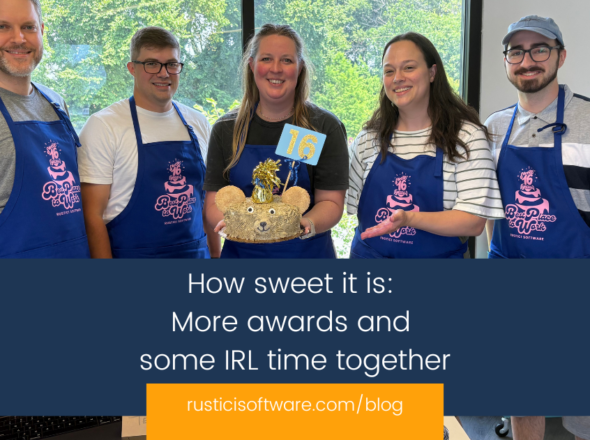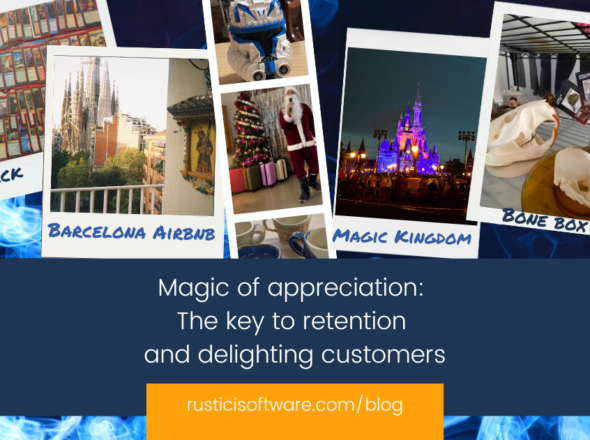Rustici added some more trophies to the mantle recently. More specifically, we were honored as the top Large Company in the Nashville Business Journal’s annual Best Places to Work awards (15 years running as a BPTW, first time in this category), and we nailed the landing at The Tennessean Top Workplaces awards, taking the top spot in the small business category for the 2nd year in a row and winning for top leadership.
Each of these honors are based solely on employee survey responses, so we hold these closer to our hearts than other types of awards. It’s always a good litmus test on where we are as a company, and often it feels like my annual review. While we may have a strong winning track record, employee satisfaction can’t be taken for granted. Assuming what has worked in the past will continue to work is a terrible idea and one that keeps me up at night.
As the team at Rustici grows, (by some definitions we’re a Large Company?!), I worry a lot about the sustainability and scalability of our culture. Can our approach to ‘how we work’ still work?
How we work: The back story
When I joined Rustici 13 years ago, we were a team of 10-15, all sharing the same office space, supporting 100 or so customers and SCORM Cloud was just getting started. We still talk about the day we celebrated our 100th SCORM Cloud customer.
The culture that Mike Rustici and Tim Martin established when they started the company (and why I came to Rustici) was founded on the idea of leading with empathy and giving people autonomy to decide what work to do and when to do it. The challenge was simple: Give us your best 40 and treat each other with care and respect.
This was not only a very conscious decision by Mike and Tim to create a workplace they wanted to come to everyday, but a practical choice as well—as we simply didn’t have the time or infrastructure to manage differently.
Building on the foundation
As we’ve grown up over the years in both team size and customer base, a lot of things have changed. We have teams of people now and more layers than before. We have processes and the ISO certs to prove it and support over 2,000 clients all around the world. We’re now a team of 60 people, located in many states and time zones.
Expanding with intention
13 years ago, Mike and Tim finally admitted it was time to hire a salesperson and, thankfully, Chris Tompkins showed up. During that process, I wrangled my way into Rustici, pitching my account management skills and convinced them that they needed someone focused on the 100 or so customers they had already landed. Should they have hired someone to take on that role sooner? Probably, but I was a welcome addition to a team and was able to show value and fill in necessary gaps quickly. They took a risk growing their business, taking on a new role they didn’t plan on, and then over time letting me build up that team, which is now going strong with eight people.
We’ve taken similar steps over the years to match pace with our growing products and customer base. We’ve had to bring on new roles and have created new functional teams. But it’s always a little scary to take that first step when expanding, and admittedly, we’re often late to the hiring party. On the flip side, when we do bring on new people, we’re quick to welcome them with wide arms and are eager to let them lead the way with their expertise.
Growing us up
When it comes to senior or management roles, you have two paths—bring someone in or bring someone up. As a smaller company, opportunities for advancement don’t come around often. This is the one category in surveys that we often see the lowest scores. So when a manager or leader moves on, promoting from within is always the place where we start. Hiring up has a cascading effect and often creates multiple opportunities for advancement.
In 2020, Tim took an even bigger risk than he did in 2013, putting me into the Managing Director role, which was probably just as scary for him as it was for me. But that also made room for others to take on larger roles. There is nothing more rewarding than moving someone up and seeing them shine.
The importance of agency
Even as we’ve grown up, we still hold fast to the foundational idea of letting people determine when and where they work. That trust goes a long way. It not only gives people flexibility to have lives outside of work, but also signals that we respect each other to make sound decisions. While I miss the days of everyone being in the same physical office space, for us, giving people autonomy to decide where they work and how to best manage their time outweighs determining where that work happens.
As we’ve grown, we have had to provide some guardrails around setting priorities. Larger teams and a growing customer base to support means that we are more intentional about the next work to be done. Identifying our most important work is the focus. But how that work happens is still up to everyone to decide.
So as we’ve matured as a business and the landscape has changed, can the original tenets for working at Rustici still remain intact and is that what people value? If survey data (and the awards that come with it) are any indication, then the answer is yes. But it has required intention and attention to make sure that what worked then can still work today. This quote from one of the employee surveys might sum it up best:
“Rustici allows you to balance work around your life, not the other way around.”


